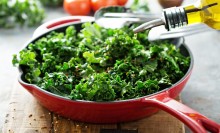General Health
For the Health of It: Go Vegetarian

Leading health experts agree that going vegetarian is the single-best thing we can do for ourselves and our families.
Every Meatless Meal Makes a Difference

At Down to Earth, we strongly believe that the single most important thing an individual can do for their health, for the environment, and for the sake of the innocent animals is to adopt a vegetarian diet. In celebration of National Vegetarian Awareness Month (October) and World Vegetarian Day (October 1st), let us take a few minutes to reflect on why.
Low-Carbon Eating: Good for Your Health, Good for the Planet

Food is often overlooked as a component of our carbon footprint, yet what we choose to eat is one of the most significant factors in the personal impact we have on the environment. A recent study examining the impact of a typical week’s eating showed that plant-based diets are better for the environment than those based on meat.1 A vegan, organic diet had the smallest environmental impact while the single most damaging foodstuff was beef. Likewise, all non-vegetarian diets require significantly greater amounts of land and water resources.
Keys to Better Health: Organic, Natural & Vegetarian

While helping to protect and sustain the earth and all her splendor is surely a worth-while endeavor, it is also important to protect and sustain our bodies with a healthy lifestyle to improve our personal quality of life. That’s because what we eat can cause or worsen illness and premature death associated with diet-related diseases such as cardiovascular disease and stroke, obesity, osteoarthritis and osteoporosis, cancer, and diabetes, among others.
Quick Tips for preparing vegetables and beans
Vegetables and beans are an important ingredient in a healthy well balanced diet. Here are some quick tips that make these jewels of the earth easy to prepare and use.
How to Make the Transition Fun
Many people who consume meat on a regular basis have experienced the desire to be a vegetarian or simply eat less meat. One of the drawbacks they feel is that they are going to be in for hard work or they might end up going hungry. But with all of the creative and inspiring vegetarians out there, changing your diet can be an easy and enlightening experience. You just need to know how to go about doing it.
Transitioning to a Healthy Diet
It does not take a lot of research and education to understand the basics of healthy eating. The primary staples of a healthy diet are whole grains, legumes, fruits and veggies, and nuts and seeds. A good model to follow when preparing a substantial meal is to be sure that the meal contains 25 percent whole grains, 25 percent high protein plant sources like tofu, beans, etc, 25 percent veggies and healthy fats like avocado, olive oil, nuts and seeds, and 25 percent fresh salad.
The Skinny on Healthy Fats
Many people are concerned about their intake of saturated fats from vegetarian foods such as nuts and seeds, coconuts, and avocados. While it is true that a high intake of saturated fat is linked to increased risk of heart disease and arteriosclerosis, it is important to understand that there is a difference between saturated fats from animal sources versus saturated fats from vegetable sources.
Simple, Tasty & Nutritious
Most people would love to have the time to indulge in nutritious culinary fantasies, making delicious meals everyday for themselves or their families. Unfortunately, most would agree that labor-intensive meals are not practical for their hectic lives. But with quick and easy healthy meal solutions, there is no reason why a person can not have their veggies and eat them too. Below are some suggestions for simple and nutritious snacks and meals that will please the whole family.
Reading Food Labels
If you have food allergies or are serious about maintaining a vegetarian diet, it is important to know how to read food labels. The new food labeling laws will make this much easier as the 8 major food allergens will now be listed on packages. However, until all labels have made this transition, it will still be necessary to carefully read ingredients. Research your particular allergy and learn the chemical names by which it may appear on a label. For example, “sodium caseinate” is a milk derivative, and “hydrolyzed vegetable protein” is a form of MSG.